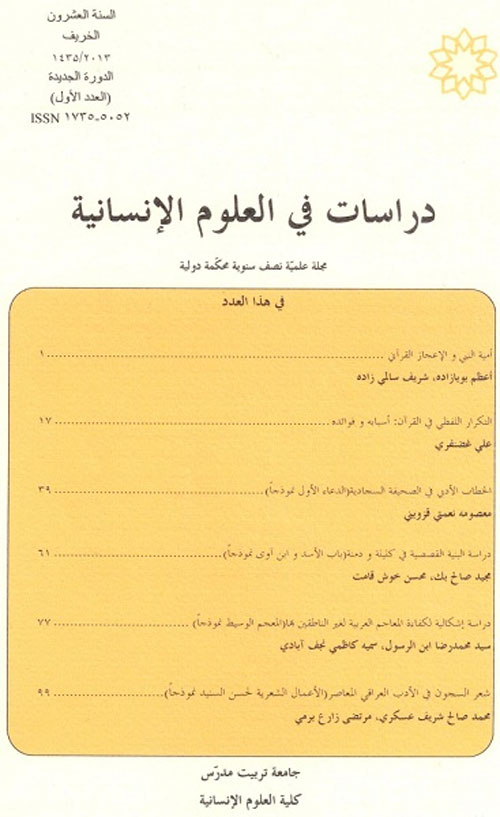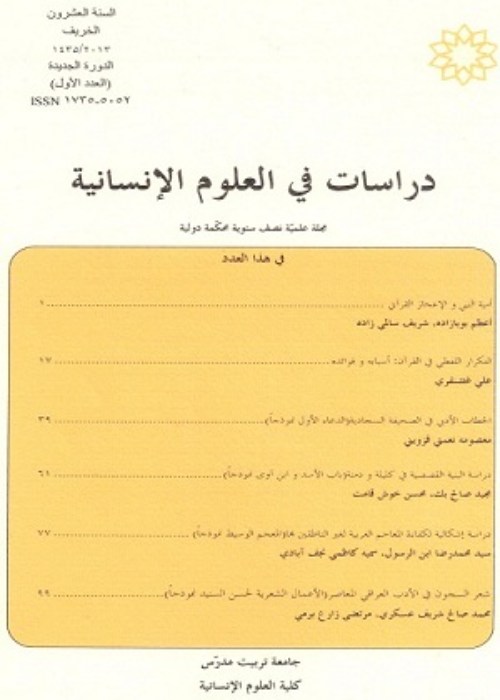فهرست مطالب

مجله دراسات فی العلوم الانسانیه
سال بیست و یکم شماره 1 (ربیع 1437)
- تاریخ انتشار: 1393/09/15
- تعداد عناوین: 6
-
-
صفحات 15-32
-
صفحات 33-56
-
صفحات 57-79
-
صفحات 81-103
-
Pages 1-14This study aims to throw light upon the experience of meeting with The Self in “The King and The Slave Girl” From Masnavi by Persian poet Jalal Al-Din Al-Rumi. This study tries to apply Carl Jung theory of Collective Unconscious. Jung was the first who discovered the presence of the collective unconsciousmind in addition to the individual unconscious mind. He believed that menhave the power of collective unconscious mind that belongs to the society andthe culture they live in. Archetypes constitute the structure of the collectiveunconscious. The most famous archetypes are Anima (The archetype of femalein man)، Animus. (The archetype of male in woman)، Shadow (The hateful partpersonality)، Wise Old Man (Archetypal image that embodies wisdom). According to these archetypes، we can say that The King in AL-Rumi storysymbolizes a Sufi who is traveling across an inner trip to obtain trueknowledge of himself. In his trip The Sufi pass through dark tunnel of soil.Keywords: Collective Unconscious, Anima, Animus, Shadow, Wise Old Man
-
Pages 15-32Since the language is a communication tool and expresses the states and mental characteristics of people according to the contexts and situations, it is natural that the sprite of a speaker or a creator of a literary work is crystallized in what he has produced. Also, it is natural that the signs with displacement and replacement provide the ground for manifesting the verbal interpretive capacities that are hidden in the template of the compounds and live, inspiring and influential structures. This paper, based on linguistics and psychology, aims to discover the effects, dimensions, and skills of emotional intelligence and interpretive features that are hidden in every word and sentence, thosewhich are put in syntactic and morphological templates and are used as rhetorical evidences. Therefore, using analytical and descriptive method and based on dimensions and skills of emotional intelligence and contingency management, which are both new and efficient discussions in psychology and management, it is attempted to analyze and describe the rhetorical evidences that are cited by the rhetoric scholars. The fact that, the rhetorical evidences imply the eternal human affection, ability of human being in managing himself, self-regulation, flexibility, innovation, offering new information, constructive views, motivations, and optimism is one of the most important results of thisresearch.Keywords: Language, Rhetoric, Semiotics, Massaging, Interpretive Capabilities, Emotional Intelligence, Contingency Management
-
Pages 33-56Omission as a public phenomenon is common in all languages including Arabic. In such cases، knowing right meaning of sentences depends on the right understanding of omission and its place because omission results in different hypotheses leading to different understandings and likely opposite understandings. Importance of omission and guessing is double in verses named as Ayat-ol-Ahkam. Different opinions of religious authorities in guessing what is omitted result in different meaning and following it issuing different Commands (Ahkam). The major and complex point of discussion in these Verses that lead to different meanings is the guessing what is omitted. Existing abundance ofomissions in these Verses including letter and word as well as sentences and as a result abundance of dowsing about what is omitted have made the current research important. There is no scientific research that could deeply study omission issue in Ayat-ol-Ahkam and answer questions such as what kind of omission has more effects and applications. So، we have no choice than to study the syntax structure of Ayat-ol-Ahkam and semantic effect of omission in these Verses by analytic-explanatory method.Keywords: Syntax Structure, Omission Semantic Denotation, Ayat, ol, Ahkam, Meaning
-
Pages 57-79New conditions that dominated Egypt in the second half of the twentieth century necessitated revising intellectual and artistic concepts there. By this way، the followers of neo-realistic trend and who tried to get closer to the reality adopted different styles to express their views. Sonallah Ibrahim is one of the neo-realist writers who believed that they should break away with classical methods of writers and portray truth with a new outlook. This novelist، in his “August Star” (1974) managed to revel the contradictionsthrough a realist method which precisely depicts everyday events and avoids any interference in the narration. The analysis of the novel elements demonstrate that the main character has been omitted from the story and different characters remain static till the end. Time goes without any significant happening and there are no “flash back” and “forward” techniques in the story. The events of the story take place in different places which have their own importance. The plot of the novel does not include conflict، climax and dénouement. Following، descriptive method، this article has tried to analyze the Neorealist and its elements and to get the ideas of critics and theorists like Allan Rob.Keywords: Sonallah Ibrahim, August Star, Neo, realism, Character, Time, Space, Plot
-
Pages 81-103Language is the fundamental of meaning and semantic in discourse، a system that is complex more than any other. In other words، a novel is a linguistic phenomenon that is an integration of different styles of speech، heteroglossia and voices where there exist dialogism relationships. Showing peculiarities of different social languages، a novel represents the dialogism relationship in a way that it can make the narratives more understandable because this multiplicity of languages is effective in the layer of discourse. Likewise، the knowledge of author about literary and non-literary texts is effective in creating inter-textual relationship with previous texts. A review of the novel language،from the view point of critical ‘dialogism’ shows how novelists apply special style، secrets، and phrase. A descriptive - analytical study shows dialogism features in the language of the novels of Ibrahim Koni. In his novels، Koni tries to portray desert and its creatures in a way that makes the desert an absolutely beautiful world with full of emotion. Even، he accords particular language to plants، animals and others desert objects. Further، he uses intertextual relationships between languages of his novel and a variety of other literary،mythological، religious and historical languages and changes the novel language into a tableau of dialogism based on language heterogeneity and ideology of desert creatures.Keywords: Dialogism, Heteroglossia, Intertextual, Novel, Ibrahim Koni
-
Pages 105-121The local accents in Arabic countries often get attention and care of both Arab and western researchers in the field of linguistics. Whenever these studies are advanced، some significant issues are clarified. We are certain that the contemporary accents possess some traditional factors used in accents before the advent of Islam. Although new accents due to their advancements in different environment have caused distances and a bit alienation and even adopted some of the local features، they could preserve many of the characteristics of the traditional Arabic language. Khuzestani Arabic accent isone which is close to the eloquent Arabic and it keeps intact some grammatical، syntactic، phonetic characteristics of the traditional Arabic. But، unfortunately، this accent was not of great attention to new researchers except for some weak and random studies. In this field study in Khuzestan، we focused on the local accent of Arabs in this province. Also، we studied phonetics and syntax، and focused on the etymology of these factors in traditional Arabic accents and then، highlighted it through examples and similarities from Qur’an. The paper concludes that many of the elements are close to the Qur’anic elements and all these findings are reasons to this accent''s originality.Keywords: Khuzestan, Arabic Accent, Phonetical Elements, the Holy Quran


